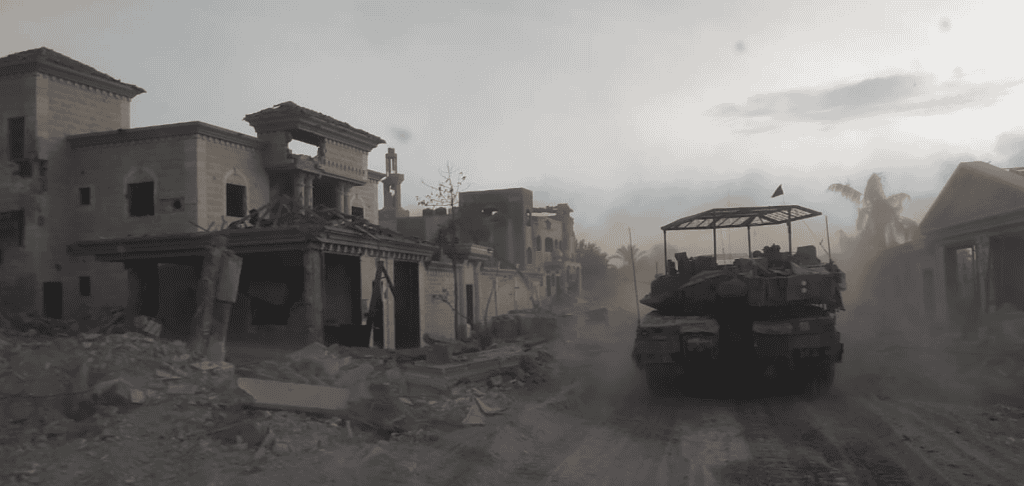
Seth Frantzman is reporting from Israel.
The Israel Defense Forces announced the deaths of 15 soldiers over the last two days suffered as casualties while Israel ground forces pushed into more urban areas in Gaza on their fifth day of ground operations. Eleven of the soldiers were Givati brigade members killed by an anti-tank missile. Others included two members of the 7th battalion, a tank unit within the 77th tank brigade. Israel has now lost 331 soldiers since the surprise Hamas attack on Oct. 7.
IDF spokesperson Rear Admiral Daniel Hagari said that Israel had breached a Hamas line of defenses, although this likely doesn’t refer to a physical barrier and frontline, rather pushing through Hamas positions in some urban areas. Israel has kept a close watch on operational security.
Israel’s Prime Minister, Defense Minister, Chief of Staff and other officials all gave statements on Wednesday, comments that came in the wake of the announcement about the fallen soldiers in Gaza. Prime Minister Benjamin Netanyahu said “we are in a difficult war. This will be a long war. We have so many important achievements but also painful losses.” Chief of Staff Herzi HaLevi said ground operations will intensify. “We are fighting for our right and the right of future generations to live in safety and prosperity in our homeland,” he said.
Defense Minister Yoav Gallant warned other terrorist groups in the West Bank, Lebanon and Syria not to threaten Israel. That came in the wake of two attacks from Yemen on Oct. 31. The threats were intercepted, but the increase in attacks from Yemen illustrated that groups linked to Iran continue to try to crack open new fronts against Israel. The IDF said they sent missile boats to the Red Sea in the wake of the attacks. Hezbollah leader Hassan Nasrallah is expected to speak Friday and his comments could further inflame the region. Gallant warned Hezbollah to look at Gaza and consider their threats. He also continued to emphasize the importance of returning the 240 hostages held by Hamas.
On Wednesday, the IDF revealed that it had struck 11,000 targets since Oct. 7. Many of those strikes took place in the first week, with the number being reduced to around 200-300 strikes per night by the third week. Brig. Gen. Itzik Cohen, commander of the 162nd division which is operating in Gaza, said forces had reached the “gates of Gaza City.” As Israel moves into these more dense areas, coordination between ground and air forces is expected to increase.
There is also increased work between air and naval forces, the IDF noted. This includes a joint multi-branch effort with air and naval forces which “is taking place to thwart threats on the ground and strike the Hamas terrorist organization.”
Threats to armored vehicles in Gaza illustrate the challenge of the conflict. For instance, images have shown that Israel has put cages on top of some armored vehicles, to defend against small commercially available drones. In addition, the anti-tank missile threat from Lebanon and in Gaza continues to be impactful. Israeli armored vehicles are often equipped with the Trophy active protection system or the Iron Fist protection system. These systems will be further tested in coming weeks. In the wake of the killing of the 11 Givati members by an anti-tank missile, the IDF and Israel Intelligence Agency (ISA) said that an IDF warplane struck Muhammad A’sar, the head of Hamas’ anti-tank missile unit in the Gaza Strip. “A’sar was responsible for all of Hamas’ anti-tank missile units throughout the Gaza Strip,” the IDF said.
Battles in neighborhood streets are also leading to high civilian casualties. An airstrike in Jabalya targeted terrorists, the IDF said, but reports in Gaza say civilians were killed as well. IDF spokesperson Hagari responded on Wednesday to these claims by noting Israel has called on civilians to leave northern Gaza and that Hamas tunnels underground and Hamas activities imperil civilians. The IDF released a conversation on Wednesday that included the commander of Hamas’s Western Jabaliya Battalion and a Gazan resident, with the participation of the director of the Indonesian Hospital, which was intercepted by Israeli Military Intelligence. The discussion centered around Hamas demanding 1,000 litres of fuel from the hospital.
Meanwhile, some civilians were able to leave Gaza via the Rafah crossing on Wednesday. These included foreign passport holders and some injured and ill who required medical treatment. There are reportedly hundreds of U.S. citizens in Gaza who want to leave and calls for a ceasefire continue abroad. Iran’s Foreign Minister flew to Turkey on Wednesday where he threatened Israel, saying that another “surprise action” could be carried out if the Gaza operation isn’t stopped. The King of Jordan also flew to the UAE on Wednesday. Jordan has repeatedly slammed Israel for launching their ground operation last Friday, which is coming at a cost.







